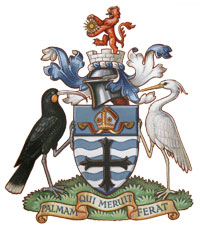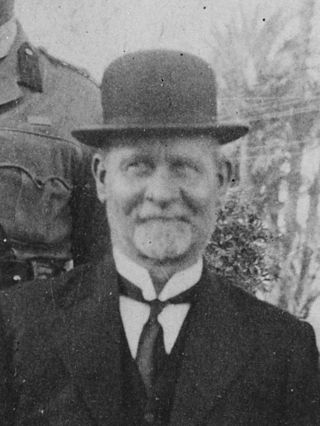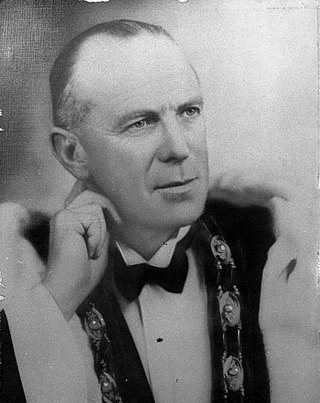
Motueka is a town in the South Island of New Zealand, close to the mouth of the Motueka River on the western shore of Tasman Bay. It is the second largest in the Tasman Region, with a population of 8,320 as of June 2023.

Nelson is a New Zealand parliamentary electorate, returning one Member of Parliament to the House of Representatives of New Zealand. From 1853 to 1860, the electorate was called Town of Nelson. From 1860 to 1881, it was City of Nelson. The electorate is the only one that has continuously existed since the 1st Parliament in 1853.
The mayor of Whanganui is the head of the Whanganui District Council. Since 1872, there have been 29 mayors. Andrew Tripe is the current mayor.
Avon is a former New Zealand parliamentary electorate. It was created for the 1861 general election and existed until 1996. It was represented by 13 Members of Parliament and was held by Independents, Liberal Party or Labour Party representatives.

Richard Phineas Hudson was a Reform Party Member of Parliament in New Zealand. Born in Ireland, he was a tea planter in British Ceylon before becoming a fruit grower in New Zealand.
Wairau was a parliamentary electorate in the Marlborough Region of New Zealand. It was one of the initial 24 New Zealand electorates and existed from 1853 until its abolition in 1938, when it was succeeded by the Marlborough electorate. The electorate had 13 representatives during its existence. The 1861 election in the Wairau electorate was notable in that a later Premier, Frederick Weld, was unexpectedly and narrowly defeated by William Henry Eyes.
Waimea was a parliamentary electorate in the Nelson Province of New Zealand, from 1853 to 1887. Initially represented by two members, it was a single-member electorate from 1861.
The Suburbs of Nelson is a former parliamentary electorate around the city of Nelson, New Zealand from 1861 to 1881.

Richmond Hursthouse was a 19th-century Member of Parliament in Nelson, New Zealand, and a cabinet minister.

Edward Baigent was a 19th-century Member of Parliament from Nelson, New Zealand. He was one of the most successful saw-millers of the region, and his company existed for well over 100 years.

The mayor of Nelson is the head of the municipal government of Nelson, New Zealand, and presides over the Nelson City Council. The mayor is directly elected using a single transferable vote electoral system. The current mayor is Nick Smith, who was elected in September 2022.

William Lock was Mayor of Nelson, New Zealand, from 1913 to 1915 and again from 1921 to 1927. Lock was an auctioneer, and a grain and produce merchant for 40 years. During his term as mayor, HMS New Zealand visited Nelson in 1913. Lock died on 20 July 1940 at his home in Collingwood Street, Nelson.

The Mayor of Thames officiated over the Thames Borough of New Zealand, which was administered by the Thames Borough Council. The office existed from 1874 until 1975, when Thames Borough and Coromandel County were amalgamated to form Thames-Coromandel District. There were 24 holders of the office.

The mayor of Blenheim officiated over the borough of Blenheim, New Zealand. The office was created in 1869 when Blenheim became a borough, and ceased with the 1989 local government reforms, when Blenheim Borough was amalgamated with Picton Borough and Marlborough County Council to form Marlborough District. There were 31 mayors of Blenheim. The last mayor of Blenheim, Leo McKendry, was elected as the first mayor of Marlborough.

The mayor of Tasman is the head of the municipal government of Tasman District, New Zealand. The mayor is directly elected using the first-past-the-post electoral system.
The Mayor of Grey, often referred to as the Mayor of Greymouth, officiates over the Grey District of New Zealand which is administered by the Grey District Council with its seat in Greymouth. The current Mayor is Tania Gibson. Two predecessors to this office were the Mayor of Greymouth, officiating over the Greymouth Borough Council from 1868, and from 1877 the chairman of the Grey County Council.
Robert Edward Hornblow was a New Zealand politician, auctioneer, reporter and newspaper proprietor.

Augustus Edward Cheesman Craig Mansford was Mayor of Palmerston North from 1931 to 1947; the longest-serving mayor in the city's history.

The Mayor of Lyttelton was the head of the municipal government of Lyttelton, New Zealand. The position existed from 1868, when the Borough of Lyttelton was formed.

William Thomas Strand was a New Zealand politician. He was Mayor of Lower Hutt on two occasions.













